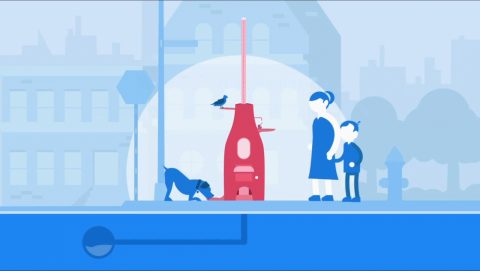
Our proposal is a spatial device for the communication of municipal drinking water quality within the public realm: a water sampling station replicated and repeated at strategic points along a public distribution system that monitors and relays critical information locally and network-wide. The Water Alert and Testing Resource (WALTER), is a place for people to see the water quality results of the local water line and test samples from their own faucets.
71% of the world’s population and over 90% of the United States has access to safely managed drinking water: a supply source located on living premises, available when needed, and free from contamination. Despite strict health standards applied to these systems, communities continue to battle deficiencies with their water quality. Oftentimes, years may pass before the public is notified of water quality violations. Simultaneous to the unfolding of quality issues in the media, we have seen a continuous rise in bottled water consumption. Could this be an indicator of public distrust in our tap water?
The water sampling project is a proposal to affect the disparity of information between water suppliers and the consuming public. By tapping into existing infrastructure, the project aims to communicate real-time water quality and consumption levels at a neighborhood scale. A renewed trust in water quality can provide local pride, decrease plastic consumption and increase public stewardship of our water systems.
We collect, pump and distribute water from natural sources to highly curated destinations for consumption, protection and health, all hidden in an extensive path of purification and pressurization and rarely revealed. Whether our infrastructure lies under or above ground, we benefit from intelligent and active landscapes that empower and elicit stewardship of our resources. By using the existing infrastructure of the 965+ water samplings stations throughout the city, we can simply replace the top access box with a communicative and technologically-advanced testing system and skin to see these small pieces of invisible infrastructure take on a heroic role in the city.
Residents of Flint, MI from 2014 to 2015 and Washington D.C. from 2000 to 2004 consumed contaminated water without public acknowledgment. Today we are grappling with the timeline and impact of Newark’s lead exposure in the water system. Unfortunately, these examples represent a small percentage of people in the U.S. that have been exposed to contaminated water. While New York City has the highest quality municipal water supply in the U.S. and a proactive list of infrastructure projects, WALTER in NYC can have three major impacts: securing trust and stewardship, future-proofing communication, and being a demonstration to other cities that have a vulnerable system that will benefit from a visible, immediate and public communication system today.
WALTER receives Architect's Newspaper Best of Design Award
WALTER receives Honorable Mention from the Architect's Newspaper Best of Design Awards.
WALTER Recognized with 2019 AIANY + ASLANY Transportation + Infrastructure Design Excellence Awards
WALTER receives Citation award in the Projects category of 2019 AIANY + ASLANY Transportation + Infrastructure Design Excellence Awards
Team
Ennead
- Alan Cation
- Stefani Fachini
- Masha Konopleva
- Ryan Lewandowski
- Amy Mielke
- Cesar Neri
- Yimika Osunsanya
- Jetnipat Phruttinarakorn
Bluecadet
- Brad Baer
- Andrew Moliski
- Sara Pasch
In Partnership With
- New York State Council on the Arts (NYSCA)
- Storefront for Art and Architecture
- Wade McGillis, Lamont-Doherty Earth Observatory, Columbia University
- Shawnee Traylor, Woods Hole Oceanographic Institution, Massachusetts Institute of Technology
- Caitlin Taylor, MASS Design Group
















